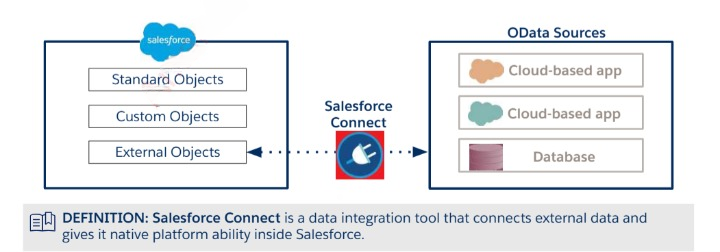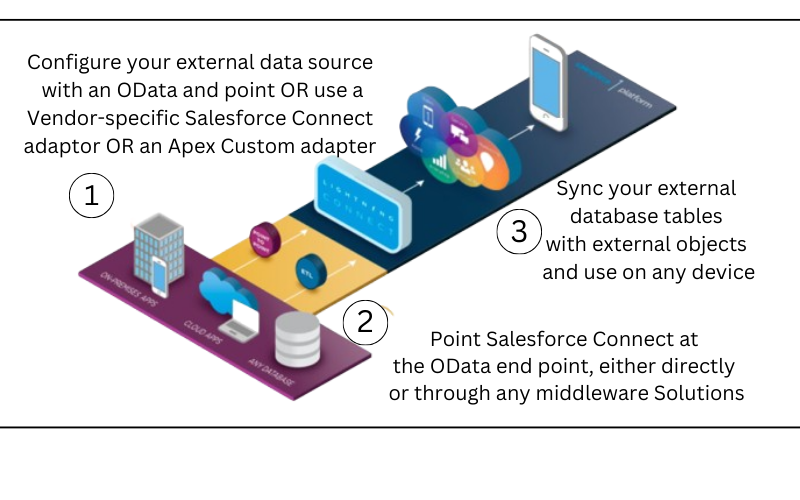Salesforce Connect is a powerful feature that automatically embeds external data into your Salesforce instance. The challenge in managing data efficiently increases as businesses grow and evolve, this is where Salesforce Connect comes to the rescue; it offers a solid system that supports real-time access for enterprise processes while ensuring consistency across different systems without syncing any data. This blog will focus on various aspects of Salesforce Connect including its merits, installation guidelines, and other important features while maintaining simplicity and user interface.

What is Salesforce Connect?
Salesforce Connect is a feature introduced to integrate external data sources with your Salesforce org, so you do not need to bring the data physically into Salesforce. This means it does not store data instead users can access the external data in real-time through Salesforce Connect using External objects, just like a standard object.
These items act like custom objects but do not store data inside Salesforce. Instead, your requests are made to the external source in real-time for data retrieval whenever you need it. Salesforce Connect allows you to view and work with this data from Salesforce so that it is a transparent user experience
- Quickly unlocks your back-end legacy data.
- Uses Industry-Standard OData Protocol
- Uses point-and-click simplicity, with No coding Required.
Benefits of Using Salesforce Connect
- Real-time data: Using Salesforce Connect you always use real-time information. Any changes on the external system are reflected immediately in Salesforce.
- Less data storage costs: As you’re not duplicating the data in Salesforce, you can significantly reduce your data storage requirements and associated costs.
- Simplified Data Management: There is no need to enter into complex data sync processes. This one seamlessly performs in the background by automatically retrieving external data through Salesforce Connect.
- Better data consistency: Sorting to a single source of that truth will eliminate the risk of your data being out-of-sync between two systems.
- Enhanced User Experience: Better user experience where users from Salesforce can see other requirements directly within the platform.

How Do You Set up Salesforce Connect
- Adapter Selection: Salesforce Connect has various adapters based on external data sources. This is where the OData adapter (although there are also adapters for SQL databases, and other Salesforce orgs) comes in.
- Salesforce Connect Activation: From your Salesforce org, go to Setup and search for “salesforce connect” or “external data sources”. From the popup, based on your need select any appropriate type (e.g., OData 2.0, OData 4.0).
- Define external objects: These are virtual representations of your external data tables. They can be created manually or by allowing Salesforce to synchronize the schema from an external source.
- Establishing Set-up Authentication: If you use an external system, there is the potential to configure the authentication flow as in OAuth or named credentials.
- Assign User Permissions: Ensure that correct users have access to the external objects and data sources.
- Build Relationships: You can establish a lookup relationship between your Salesforce objects, and external objects newly established.
What is OData?
OData (Open Data Protocol) is an open protocol and an OASIS standard for building and consuming RESTful APIs. It’s the main protocol to communicate with data in an external source using Salesforce Connect.
OData brings a uniform way to represent data and an associated application schema (the entity data model) for interoperability among different services. This can be extremely advantageous for enterprises to integrate Salesforce with numerous external systems to simplify the integration system.
OData carries various data operations such as filtering, sorting, and pagination. It’s a perfect choice for working with large datasets. Due to this property, Salesforce can confidently work with external metadata and interact effectively.
- Provides a Rest-based protocol for CRUD operations against resources exposed as Data services.
- Data is Exposed as Collection. Each collection has Entries, that are typed named-value pairs.
- Use JSON or Atom format for its request and response bodies
Salesforce Consideration:
While Salesforce Connect offers numerous benefits, it’s essential to consider a few factors before implementation:
- Performance: As we know Salesforce Connect is real-time data access, it depends on network latency so performance could be impacted. Prepare your network infrastructure to support the extra load.
- Volume of data: Although Salesforce Connect can support large amounts of data, if you are working with massive datasets, consider limitations on API usage and the impact on performance.
- Licensing: Access to Salesforce Connect and its functionalities may require an additional licensing purchase, review all costs associated with external data sources, and allow you to review the license requirements set by Salesforce.
- Security: Think about the security restriction before connecting to external data sources. Implement differentiated security authentication and controls.
- Compatibility: A few Salesforce features will only work partially with external objects. Use the Vision SDK with a supported device or simulator, and test extensively to meet your use case.
- Cost: While Salesforce Connect can help you reduce storage costs, it requires an additional license too. Check to see the cost-benefit ratio for your organization.
- Maintenance: It is important that any changes in the schema to the external data source can mean an update on the Salesforce Connect configuration
Final Thoughts:
Salesforce Connect is a game-changer for how your organization manages and consumes data. Salesforce Connect gives businesses real-time data access, and storage cost cutback and helps in integration simplification for addressing the full potential of their external systems from inside Salesforce. Although it needs to be planned accordingly, the rewards of seamless data integration can save many businesses numerous man-hours.
Resources
- [Salesforce Trailhead] (https://trailhead.salesforce.com/)
- [Salesforce Developer] (https://developer.salesforce.com/)
- [Salesforce Success Community] (https://success.salesforce.com/)
- [Salesforce Developer Community] (https://developer.salesforce.com/forums)
For more insights, trends, and news related to Salesforce, stay tuned with Salesforce Trail
Join Our WhatsApp Group – “Visit Here”
Join Our Telegram Group- “Visit Here”
- adminhttps://salesforcetrail.com/author/admin/
- adminhttps://salesforcetrail.com/author/admin/
- adminhttps://salesforcetrail.com/author/admin/
- adminhttps://salesforcetrail.com/author/admin/



